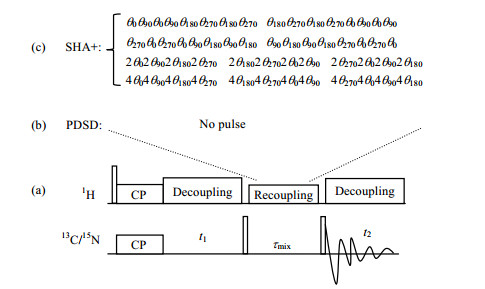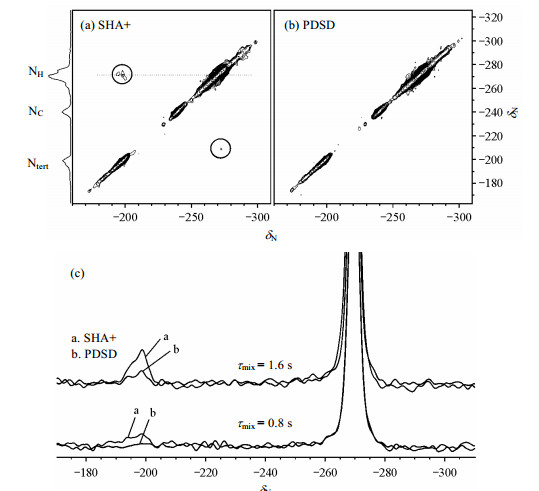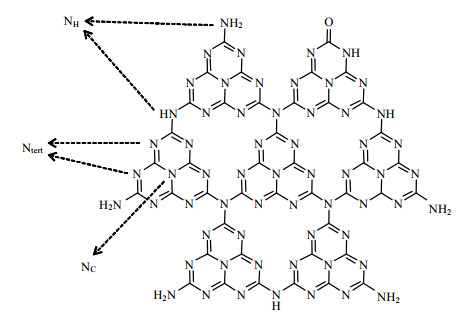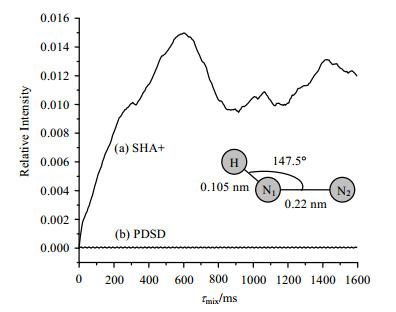Article Information
- 闫晓静, 胡炳文
- YAN Xiao-jing, HU Bing-wen
- SHA+脉冲序列用于g-C3N4样品15N-15N相关性的固体核磁共振研究
- Probing 15N-15N Correlations in g-C3N4 Samples with Solid-State NMR SHA+ Pulse Sequence
- 波谱学杂志, 2016, 33(3): 361-367
- Chinese Journal of Magnetic Resonance, 2016, 33(3): 361-367
- http://dx.doi.org/10.11938/cjmr20160301
-
Article History
Received date: 2015-03-11
Revised date: 2016-07-15


DOI:10.11938/cjmr20160301
Solid-state nuclear magnetic resonance (SS-NMR) spectroscopy, with atomic resolution, permits probing the structure and dynamics of biological and material systems[1-7]. However, the lacks of sensitivity and resolution are often the two major limitations for the investigation of complex solid systems. Both limitations are attenuated by using high static magnetic field B0 and fast magic angle spinning (MAS) frequencies to remove the anisotropic parts of interactions. Through-space homo-nuclear and hetero-nuclear correlations are widely used under MAS for resolution purpose to probe the structures. However, the dipolar couplings have to be restored under MAS. Among various homo-nuclear recoupling (HOMCOR) methods, spin diffusion is widely used since it is little sensitive to dipolar truncation and can probe long distance correlations. For 13C-13C experiments, proton-driven spin-diffusion (PDSD)[1], dipolar-assisted rotational resonance (DARR)[8, 9], phase-alternated recoupling irradiation schemes with xy phases (PARISxy)[10-12], second-order Hamiltonian among analogous nuclei generated by hetero-nuclear assistance irradiation (SHANGHAI)[13], and second-order Hamiltonian among analogous nuclei plus (SHA+)[14] have been demonstrated. All these sequences are second-order recoupling methods. In PDSD [Fig. 1(b)] experiments, no recoupling pulse is sent during the mixing time (τmix). While in SHA+ experiments [Fig. 1(c)], recoupling pulses with different lengths and/or phases are sent. It has been shown that by using recoupling pulses in the mixing time, the signal transfer between 13C nuclei is more efficient than that without any pulse.

|
| Fig. 1 (a) General scheme of 2D second-order 15N-15N spin diffusion experiments with recoupling sequences applied on the 1H channel during the mixing time (τmix), (b) PDSD pulse sequence, (c) SHA+ pulse sequence. For each pulse, the length is indicated as a multiple of θ(θ=TR/2, TR is the rotor period) and the phase is given on the right |
However, for 15N-15N experiments, PDSD is usually preferred since the dipolar couplings between 15N nuclei are always very small, hence leading to very long (≈ 1 s) mixing times, which make most of the second-order methods with recoupling pulses inefficient. In this communication, using g-C3N4 which is a material used in photocatalysis as a sample, we demonstrate that the SHA+ recoupling pulse sequence can be used for 15N HOMCOR and it is much more efficient than PDSD. The SHA+ scheme has been derived on the basis of the super-cycling of SHANGHAI sequence using Floquet theory[15, 16]. It concatenates 1H irradiation with three different pulse lengths:TR/2, TR and 2TR.TR=1/vR, is the rotor period, and vR is the spinning frequency. The super-cycles will last for 64 TR. The use of different pulse lengths and phases allows increasing the number of modulation-sidebands and hence the number of efficient recoupling conditions. Our results show that SHA+ pulse sequence can be useful for the structural analysis of different kinds of nitrogen-doped carbon materials, such as nitrogen-doped graphene.
1 ExperimentalExperiments have been performed on a Bruker AVANCE-Ⅲ 600 MHz spectrometer (B0=14.1 T). A commercial Bruker HX double-resonance MAS probe with rotor of 4 mm outer diameter was used, and spinning frequency vR was set to 10 kHz for all experiments. In this case, the same use of probe, sample volume and mixing time allows an easy quantitative comparison of the transfer efficiencies. The temperature is controlled by cooling gas.
For increasing the NMR detection sensitivity of the 15N nucleus, a 15N-enriched g-C3N4 (enrichment of ca. 20%) was synthesized starting from 15N-labeled melamine, which was prepared according to the procedure introduced by Jurgens et al[17].
The simulations were performed using SIMPSON V4.1.1 software[18]. The powder averaging was accomplished using 1 680 crystallite orientations. The 168 (αMR, βMR)-pairs, which relate the molecular and rotor frames, were selected according to the REPULSION algorithm[19], and the 10 gMR-angles were regularly spaced between 0°~360°.
2 Results and discussionFig. 2 shows the experimental 2D SHA+ [Fig. 2(a)] and PDSD [Fig. 2(b)] 15N-15N correlation spectra of g-C3N4sample displaying at the same counter levels. The 15N signals were referenced with respect to nitromethane. Typical 90°pulse lengths of 1H and 15N were 4 ms and 9 ms, respectively. The contact time for cross-polarization was 1 ms, and SPINAL-64 proton dipolar decoupling sequence was used during evolution and detection periods[20]. Recycle delays were set to 2 s for all experiments. For each t1 step, 96 scans were accumulated. τmix was set to 0.8 s or 1.6 s. The 1H radio frequecy (rf) power of the SHA+ sequence was set to 10 kHz. Additional experimental details are given in the figure captions.

|
| Fig. 2 2D 15N-15N correlation spectra of polymeric graphitic carbon nitride using (a) SHA+ and (b) PDSD schemes with τmix=0.8 s, (c) Comparison of the row slices taken at dN-270 for τmix=0.8 s and 1.6 s. The 1D MAS spectrum is shown on the left of (a) |
Resonances have been assigned according as the literature[21]. The signals of δN-260~-280 were assigned as protonated nitrogen sites of NH2 and NH (referred as NH in Fig. 3). The signals of δN-190~-210 were assigned as tertiary nitrogen Ntert from N-C(NH) or N-C(NH2)[21].And the signals of δN-230~-240 were assigned as the central nitrogen atom (Nc) of the heptazine core[21].

|
| Fig. 3 Structure model for g-C3N4 with the three different kinds of nitrogen species indicated |
It is obvious from the Fig. 2(a) and Fig. 2(b) that with τmix=0.8 s, PDSD is not able to probe any correlations between nitrogen nuclei, while the SHA+ identifies a cross-peak from the NH to the Ntert. There is no cross-peak from the Ntert to the NH, which is due to the short spin-lattice relaxation time (T1) of Ntert. It is obvious from Fig. 3 that the NH atoms are close to the Ntert, with a distance of r ≈ 0.22 nm corresponding to a dipolar coupling of |d/2π| ≈ 115 Hz. And the existence of protons in the NH groups (NH or NH2) accelerates the magnetization transfer from the NH to the Ntert. On the contrary, the NC is far away from the NH groups (r ≈ 0.38 nm, |d/2π| ≈ 22 Hz), and therefore SHA+ cannot probe this correlation. Furthermore, both SHA+ and PDSD sequences can not probe the correlation between the Ntert and the NC, in spite of their short distances (r ≈ 0.22 nm, |d/2π| ≈ 115 Hz) due to the absence of the protons between them. These results demonstrate the importance of protons in the second-order recoupling methods.
To further compare the transfer efficiency of SHA+ and PDSD in this experiment, we show in Fig. 2(c) the row slices taken at δN-270 for these two approaches with τmix=0.8 s and τmix=1.6 s. It is noticed that the cross-peak is more intense with SHA+ recoupling scheme. Moreover, the comparison of the slices proves that SHA+ accelerates the magnetization transfer between different 15N sites by a factor of ca. 2. Indeed, the same cross-peak intensity is observed in SHA+ with τmix=0.8 s as in PDSD with τmix=1.6 s. It should be pointed out that we use only 10 kHz 1H rf power for SHA+ recoupling at vR=10 kHz and the irradiation time set to 1.6 s on 1H channel which would not damage the 1H amplifier.
To compare with our experimental results, we have simulated the transfer efficiency versus τmix for SHA+ and PDSD sequences. Simulations were performed on a N1H-N2 spin-system, where the inter-nuclear distances are r(N1-N2)=0.22 nm, r(N1-H)=0.105 nm, and r(N2-H)=0.311 nm. The chemical shift anisotropies (CSAs) of 15N and 1H nuclei were 0, and the isotropic chemical shifts of N1 and N2 were±2.4 kHz. This configuration is similar with the configuration of 15N species in the g-C3N4 samples. It is obvious from Fig. 4 that SHA+ is much more efficient than PDSD.

|
| Fig. 4 Simulated recoupling efficiency of 15N-15N recoupling sequences with (a) SHA+ and (b) PDSD schemes. The spin-system is N1H-N2 (see the insert), the isotropic chemical shifts of N1 and N2 are±2.4 kHz, and no chemical shift anisotropy is introduced |
It should be mentioned that the simulation results are different from the experimental results, especially the simulation of the PDSD, since (1) the simulations were done for three-nuclei system of N1H-N2, while the real systems have more protons; (2) the effect of the relaxation has not been considered in the simulations; (3) the simulations do not consider the longitudinal spin exchange phenomenon has not been considered in the simulations[22]. Without the longitudinal spin exchange phenomenon, the simulation results for PDSD are always 0. It should be also pointed out that although the intensity of the SHA+ simulation with N1H-N2system reaches the maximum at τmix=0.6 ms, in the real system the efficiency of SHA+ increases with the increase in the recoupling time as demonstrated in Fig. 2, since the real system has more protons, among which some are far away from 15N while some are close to 15N.
3 ConclusionWe have proposed a broadband spin diffusion experiment assisted by 1H irradiation—SHA+, which allows more efficient 15N-15N correlations than PDSD at high magnetic fields and moderate MAS frequencies. This method is little sensitive to dipolar truncation, allowing polarization transfer between 15N atoms with one nitrogen bonded to protons. Our investigations should become valuable for SS-NMR experiments in material science, especially it can be applied to nitrogen-doped carbon-based materials.
Acknowledgement: Authors would like to acknowledge Large Instruments Open Foundation of East China Normal University, National Natural Science Foundation of China (21373086), National Science Fund of China for Excellent Young Scholars (21522303), and Basic Research Project of Shanghai Science and Technology Committee (14JC1491000).| [1] | Castellani F, van Rossum B, Diehl A, et al. Structure of a protein determined by solid-state magic-angle-spinning NMR spectroscopy[J]. Nature , 2002, 420 (6911) : 98-102 DOI:10.1038/nature01070 |
| [2] | Lange A, Becker S, Seidel K, et al. A concept for rapid protein-structure determination by solid-state NMR spectroscopy[J]. Angew Chem Int Ed Engl , 2005, 44 (14) : 2089-2092 DOI:10.1002/(ISSN)1521-3773 |
| [3] | Wasmer C, Lange A, van Melckebeke H, et al. Amyloid fibrils of the HET-s (218-289) Prion form a b solenoid with a triangular hydrophobic core[J]. Science , 2008, 319 (5869) : 1523-1526 DOI:10.1126/science.1151839 |
| [4] | Lange A, Giller K, Hornig S, et al. Toxin-induced conformational changes in a potassium channel revealed by solid-state NMR[J]. Nature , 2006, 440 (7086) : 959-962 DOI:10.1038/nature04649 |
| [5] | Renault M, Cukkemane A, Baldus M. Solid-state NMR spectroscopy on complex biomolecules[J]. Angew Chem Int Ed Engl , 2010, 49 (45) : 8346-8357 DOI:10.1002/anie.201002823 |
| [6] | Hong M, Zhang Y, Hu F H. Membrane protein structure and dynamics from NMR spectroscopy[J]. Annu Rev Phys Chem , 2012, 63 : 1-24 DOI:10.1146/annurev-physchem-032511-143731 |
| [7] | Tycko R. Solid-state NMR studies of amyloid fibril structure[J]. Annu Rep Phys Chem , 2011, 62 : 279-299 DOI:10.1146/annurev-physchem-032210-103539 |
| [8] | Takegoshi K, Nakamura S, Terao T. 13C-1H dipolar-assisted rotational resonance in magic-angle spinning NMR[J]. Chem Phys Lett , 2001, 344 (5) : 631-637 |
| [9] | Takegoshi K, Nakamura S, Terao T. 13C-1H dipolar-driven 13C-13C recoupling without 13C rf irradiation in nuclear magnetic resonance of rotating solids[J]. J Chem Phys , 2003, 118 (5) : 2325-2341 DOI:10.1063/1.1534105 |
| [10] | Weingarth M, Masuda Y, Takegoshi K, et al. Sensitive 13C-13C correlation spectra of amyloid fibrils at very high spinning frequencies and magnetic fields[J]. J Biomol NMR , 2011, 50 (2) : 129-136 DOI:10.1007/s10858-011-9501-9 |
| [11] | Weingarth M, Bodenhausen G, Tekely P. Broadband carbon-13 correlation spectra of micro crystalline proteins in very high-magnetic fields[J]. J Am Chem Soc , 2009, 131 (39) : 13937-13939 DOI:10.1021/ja9036143 |
| [12] | Weingarth M, Demco D E, Bodenhausen G, et al. Improved magnetization transfer in solid-state NMR with fast magic angle spinning[J]. Chem Phys Lett , 2009, 469 (4, 5, 6) : 342-348 |
| [13] | Hu B W, Lafon O, Trébosc J, et al. Broad-band homo-nuclear correlations assisted by 1H irradiation for bio-molecules in very high magnetic field at fast and ultra-fast MAS frequencies[J]. J Magn Reson , 2011, 212 (2) : 320-329 DOI:10.1016/j.jmr.2011.07.011 |
| [14] | Hu B W, Trébosc J, Lafon O, et al. Very-long-distance correlations in proteins revealed by solid-state NMR spectroscopy[J]. Chem Phys Chem , 2012, 13 (16) : 3585-3588 |
| [15] | Scholz I, van Beek J D, Ernst M. Operator-based Floquet theory in solid-state NMR[J]. Solid State Nucl Magn Reson , 2010, 37 (3, 4) : 39-59 |
| [16] | Leskes M, Akbey Ü, Oschkinat H, et al. Radio frequency assisted homo-nuclear recoupling, a Floquet description of homo-nuclear recoupling via surrounding hetero-nuclei in fully protonated to fully deuterated systems[J]. J Magn Reson , 2011, 209 (2) : 207-219 DOI:10.1016/j.jmr.2011.01.015 |
| [17] | Jurgens B, Irran E, Senker J, et al. Melem (2, 5, 8-Triamino-tri-s-triazine), an important intermediate during condensation of melamine rings to Graphitic Carbon Nitride: synthesis, structure determination by X-ray powder diffractometry, solid-state NMR, and theoretical studies[J]. J Am Chem Soc , 2003, 125 (34) : 10288-10300 DOI:10.1021/ja0357689 |
| [18] | Bak M, Rasmussen J T, Nielsen N C. SIMPSON: A general simulation program for solid-state NMR spectroscopy[J]. J Magn Reson , 2000, 147 (2) : 296-330 DOI:10.1006/jmre.2000.2179 |
| [19] | Bak M, Nielsen N C. REPULSION: A novel approach to efficient powder averaging in solid-state NMR[J]. J Magn Reson , 1997, 125 (1) : 132-139 DOI:10.1006/jmre.1996.1087 |
| [20] | Fung B M, Khitrin A K, Ermolaev K. An improved broadband decoupling sequence for liquid crystals and solids[J]. J Magn Reson , 2000, 142 (1) : 97-101 DOI:10.1006/jmre.1999.1896 |
| [21] | Lotsch B V, Dçblinger M, Sehnert J, et al. Unmasking melon by a complementary approach employing electron diffraction, solid-state NMR spectroscopy, and theoretical calculations; structural characterization of a carbon nitride polymer[J]. Chem Eur J , 2007, 13 (17) : 4969-4980 DOI:10.1002/(ISSN)1521-3765 |
| [22] | Vosegaard T. Challenges in numerical simulations of solid-state NMR experiments: Spin exchange pulse sequences[J]. Solid State Nucl Magn Reson , 2010, 38 (4) : 77-83 DOI:10.1016/j.ssnmr.2011.01.002 |
 2016, Vol. 33
2016, Vol. 33



